"Neither a borrower nor a lender be, do not forget, stay out of debt. Think twice and take this good advice from me: guard that old solvency." Those of you who are Gilligan's Island fans may remember this sage piece of advice, given by Polonius (the Skipper) to Laertes (Mary Ann) and sung to the Toreador Song (Carmen). But if you look at our current national debt exceeding 15.7 trillion, apparently few of our elected officials in Washington either value this advice or are Gilligan's Island fans.
The national debt should be an important issue for President Obama, former MA Governor Mitt Romney, and all congressional candidates. And while there is plenty of blame to go around for why the debt is as high as it is today, in fairness our government has not always been this fiscally irresponsible. In fact a close look at history shows that Congress and the president did a much better job of staying out of debt for a long time, even before Gilligan's Island came along.
The first tracking of our national debt was set up in the 18th Century (1790s) by Treasury Secretary Alexander Hamilton. The National Debt as a percentage of Gross Domestic Product (GDP) was low from the 1790s up to 1900, maxing out at 35% of GDP during the Civil War but by 1900, the total debt was less than 20% of GDP and stood at $2,136,961,091.67.
Federal Debt was much higher in the 20th Century. Peak periods included after World War 1 (35% of GDP, dollar amount of 26 billion), the Great Depression (40% of GDP, 43 billion), World War 2 (from 45% of GDP and 49 billion in 1941 to a whopping 122% of GDP and 269 billion in 1946), the Reagan and Bush presidencies from 1980-1992 (maxing at 66% of GDP and 4.2 trillion in 1992) and the Clinton presidency (from 68% of GDP in 1993 to 58% of GDP and 5.7 trillion in 2000).
And this century, the National Debt keeps going up. CBS News pointed out recently that the Debt rose $4.899 trillion during the two terms of the Bush presidency, and as of 3/19/12 it was up $4.939 trillion since President Obama took office (3+ years, still in 1st term). Currently debt exceeds 100% of GDP.
While it is clear that more debt has been accumulated in less time under President Obama than President George W. Bush, both parties, Republican and Democrat, have contributed substantially to our debt. What causes debt? War, entitlements, and overall-- the failure of Washington to live within its means. The continual raising of the debt ceiling and spending, regardless of the mounting debt, shows a lack of fiscal discipline and an apparent disregard for the impact this debt will have on current and future generations of Americans (currently debt to be paid is $50,134 per citizen and $138,391 per taxpayer) .
Are there solutions being offered? Well, yes. But according to a report released in February, 2012 by U.S. Budget Watch, a project of the bipartisan Committee for a Responsible Federal Budget, only GOP presidential candidate Ron Paul is credited with having a plan to reduce the debt. Paul's plan shows reductions in taxes and spending, with greater reductions in spending.
Dr. Paul deserves credit for offering a clear vision of how he would reduce debt, and other candidates like Mr. Obama and Mr. Romney should be asked to do the same. But given the performance of both political parties, as both have had control of the presidency and Congress, it is hard to be optimistic that either is serious about reducing the debt.

